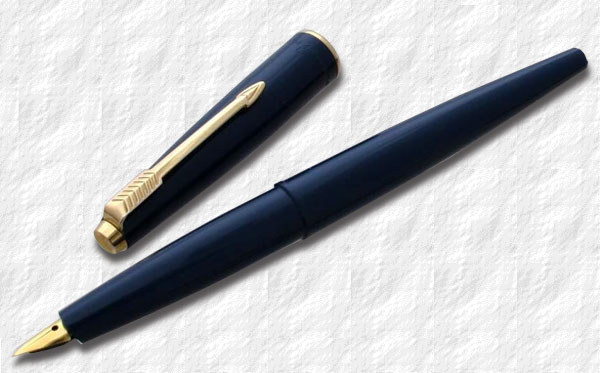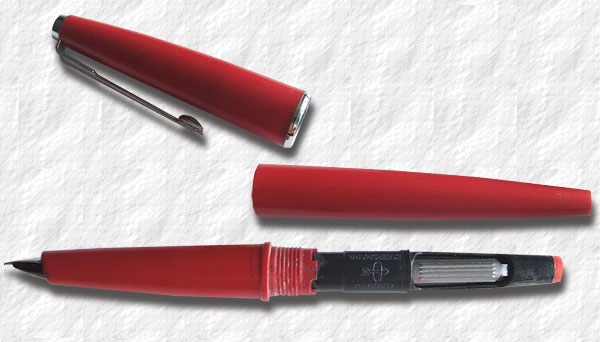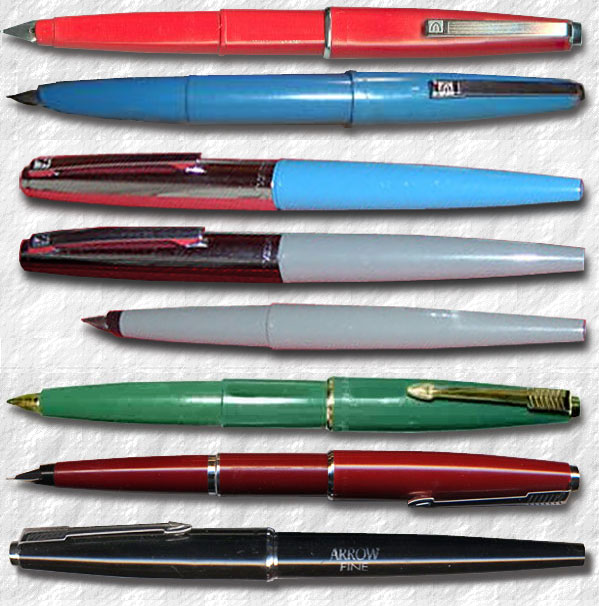
| parkerpens.net |
| PARKERCOLLECTOR.COM |
|
Parkercollector.com — Online for 24 years! Click to read:
|
1961-1963 |
|
This first cartridge was however made in glass and subsequently it broke easily and never really took off in the US, although it became quite popular on the European continent on account of it's obvious simplicity. During the 1940's most companies were looking into the new invention, the ball pen, and some companies, like Eversharp, began manufacture a ball pen with a cartridge filler, the CA, so called because it used a Capillary Action. These pens were however short lived and the cartridge was not very well designed. This pen actually led to the demise of the Eversharp pen company in 1957.
They had also had a short lived experiment with a cigarette lighter called the Parker Flaminaire (1950-1952) that contained a replacable cartridge of liquid lighter fluid. Unfortunately these cartridges could not easily be refilled, which soon rendered the discontinued lighter useless. Parker had many complaints from dissatisfied customers that had paid good money for a lighter that would no longer work. Parker decided to learn from that experience and when they later on decided to produce a cartridge, it was destined never to change. You can take any Parker cartridge from any time period and stick it into any cartridge Parker pen and it will fit. Simple, but very customer friendly. |
 |
|
A 1961 Parker "19" GT, made in Canada Image © courtesy of Goodoldnorm
|
|
The Parker 19 range:
|
|
Yes, the concept of an easily replacable cartridge was attractive. Based on the aquired Eversharp patent Parker began producing plastic ink cartridges already in 1957-58. They sported the dual inscription "Super Quink — fits Eversharp and Parker". Some say that the cartridge patent was the main reason for aquiring Eversharp, although Parker decided to take it one step further. Why force the customer to choose between cartridges and ink bottles? Parker constructed a removable, refillable ink converter that would fit into the new cartridge pen. in 1958 Parker decided to try the new cartridge in their top Parker "51" line. This was highly unsuccessful, probably because it's disposable features somehow lessened the status of owning a Parker "51". The cartridge Parker "51" was abruptly discontinued in 1962. But before then Parker had decided on a new strategy.
The first Parker "45's" had a completely new kind of steel nib. It was triangular and very small, compared to prior Parker nibs. The complete nib/feed could be unscrewed and easily replaced and many styles of nibs were offered. The patents showing the Parker "45" nib, collector and the converter was filed in 1960 and states Homer T. Green as the inventor. The new pen was introduced in 1960 and was sold alongside the Eversharp "10.000". |
 |
|
A 1961 Parker "19" CT, made in Canada. Image © courtesy of Antiquus
|
|
here was also a sister pen to the Parker "19" produced under the Eversharp name, Big E, they are virtually identical, save for the clip, imprints and the section being a tad smaller close to the nib. The Big E was made from the same plastic as the Parker "19". Both pens priced at $2.98, $5 for a ball point/fountain pen set set. The Parker "19" was trademarked in 1961.
Around 1956 German molding engineers had begun experimenting with ways to eliminate the faults of the plunger-type molding machines. They came up with a technique of using a large screw to obtain a constant flow of plastic through the heating system and into the mold, it had the additional advantage that the plastic was kept constantly moving, which rendered a more even temperature. Furthermore the changing of colour now took ten minutes, and left almost no discoloured plastic waste. Also the need for high pressure was diminished and thus more complex parts could be molded. |
|
A plastic capped companion to the Big E, the Eversharp Challenger, "Will challenge competition" was also introduced at a meager $1.00. With two free cartridges it was also sold bubble packed to a card. Colours offered were: black, red,deep blue, grey, green and light blue. Furthermore in 1962 the Eversharp "10.000" cartridge pen, which sold for $1.98 also with two free cartridges, as a promotion was offered with an additional coupon which allowed for a refund of $1.00 together with the two used cartridges. Colours offered was black, red, blue, grey, green and white but it was clearly running out of speed.
The Parker "19" is by all means a cheap Parker, significant only because it's rather rare, with only a one year+ run, perhaps with an added value as a curiosity to the Parker "45" collector and, of course, in pen history. It was phased out in 1963. |
|
© 1995-2020 Tony Fischier and The Parker Pen Company®/Sanford Ecriture. Everything on this website is copyrighted by law and can not be used without written permission from the author, Tony Fischier. You may however use the information as reference material and although it is forbidden to make digital copies or reproductions it may be physically printed for personal use, after a small donation, this does not include use on other web pages or in advertising. You may however quote parts of the content of this website, digitally or physically, providing that the source and author is clearly stated, together with the copyright information. In the US referred to as Fair use. If you use any information from this site for online purposes, you are required to add a link to this site. Feel free to donate through Paypal to help this site to stay online. This page is in no way sponsored by or created by the Parker Pen Company®. All opinions, views, and thoughts expressed herein are expressly the authors, and in no way reflect the opinions, views, or thoughts of the Parker Pen Company®/Sanford Ecriture. All logos and/or images on these pages are © Copyright of Parker Pen Company®Sanford Ecriture unless otherwise stated, and is reprinted by kind permission. If You feel that Your copyright has been violated please contact the WEBMASTER. |


